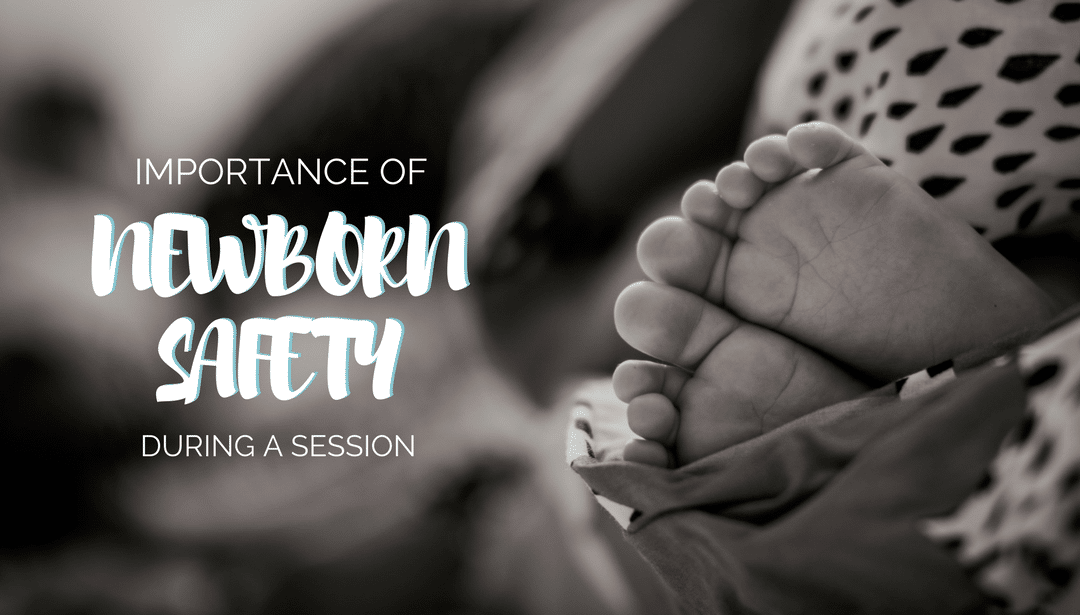
As a newborn photographer, you are in charge of photographing someone’s newest little member of the family.
This opportunity should be considered a huge honor and a responsibility that shouldn’t be taken lightly. Your client has entrusted you with capturing their baby’s infancy, sharing, on film, the essence of the baby’s nascent self. Not to be overly dramatic, but it’s true: For a few hours, you are in charge of that baby’s well-being.
Whether you are new to this type of photography or have made a career out of newborn photography it’s a good reminder to double check the safety measures you use while photographing these important bundles of joy.
Here are just a few newborn photography safety steps to do each session:
1. Always Have a Spotter
A rule of thumb in newborn photography safety is including a spotter in the session. If you don’t usually have an assistant who can perform this role, have mom provide an extra hand. Babies can move suddenly and you don’t want their head to be unsupported or have them fall in any way. By ensuring that there is an extra set of hands on location, you ensure that the baby stays safe and you can direct your attention toward capturing moments.
2. Check for Circulation During the Session
As you photograph your newborn subject, check arms, legs, fingers, and toes for good circulation during the session. Be aware of any props or costumes that might impact circulation. For example, don’t wrap newborns too tightly and always be sure there isn’t any fuzz from rugs covering any part of the newborn’s body. Have the parents do a double check before they leave as well to ensure newborn photography safety.
3. Be Aware of the Baby’s Comfort Level
While your little subject can’t tell you if a pose or garment is uncomfortable, their actions can show you. Pay attention to the baby’s comfort. If it seems like they don’t want to move into a pose, don’t force them. It’s natural for babies to resist specific positions. Find a pose that is comfortable for them and work from there.
4. Ease into Advanced Posing
Don’t rush into advanced posing at first (think: head in hands/froggy pose). Take your time mastering simpler poses before you move to more complicated ones to practice newborn photography safety.
5. Be Aware of Room Temperature
Keep the room nice and warm, but ensure heaters aren’t too close to the photography area. Keeping your young subject comfortable will be a big help as you capture gorgeous portraits.
6. Remove Fragile Props
Never put the baby inside anything that might break or harm them, such as glass and ceramic items.
7. Maintain Proper Positions
Always keep the baby in a low position when doing hanging poses or holding poses. Keep a supportive beanbag really close, right underneath the baby and always have an extra set of hands to spot the baby. This way, if anything were to happen, the baby would be caught by the spotter or the beanbag, ensuring newborn photography safety.
8. Weight Prop Boxes
If you are laying the baby in a prop, like a basket or box, add weights to the bottom to prevent tipping. Also put soft padding or blankets over the edges to keep the baby comfortable.
9. Compositing is Your Friend
Use compositing when necessary and know what poses it needs to be used for. It’s as simple as merging a few images in photoshop! If you’re new to this type of photoshop skill, there are many YouTube tutorials out there that you can watch to learn how it’s done. Examples of how this is accomplished:
- Head in hands – Take one image that has your spotter supporting the head from the top. Then take a photo where your spotter is supporting the baby by holding the arms. Then merge the two images by creating layers and erasing where the hands are in each image, being careful to line them up.
- Baby in sling – Have mom or dad hold the baby in a sling low over a bean bag with spotter hands on the baby. Then take a second image that has the sling without the baby, using something inside to weigh it down to get a similar pull in the fabric. Combine the two images in photoshop.
We recommend also reading this amazing post on posing safety by Kelly Brown. It does a great job of explaining how to use composite images for certain poses and how to understand the comfort level of the baby for a successful session.
What are your newborn photography safety tips?
—
Are you ready to take your business to the next level? Sign up for a free trial with Iris Works and let us help handle your everyday tasks!
Recent posts


